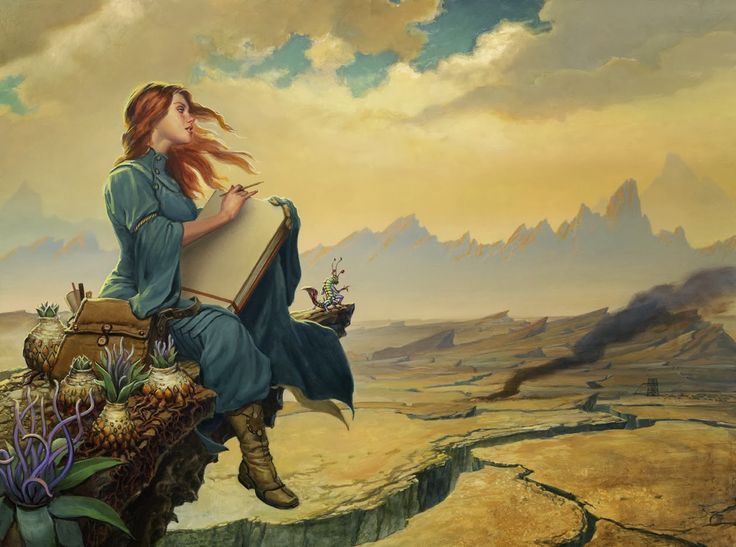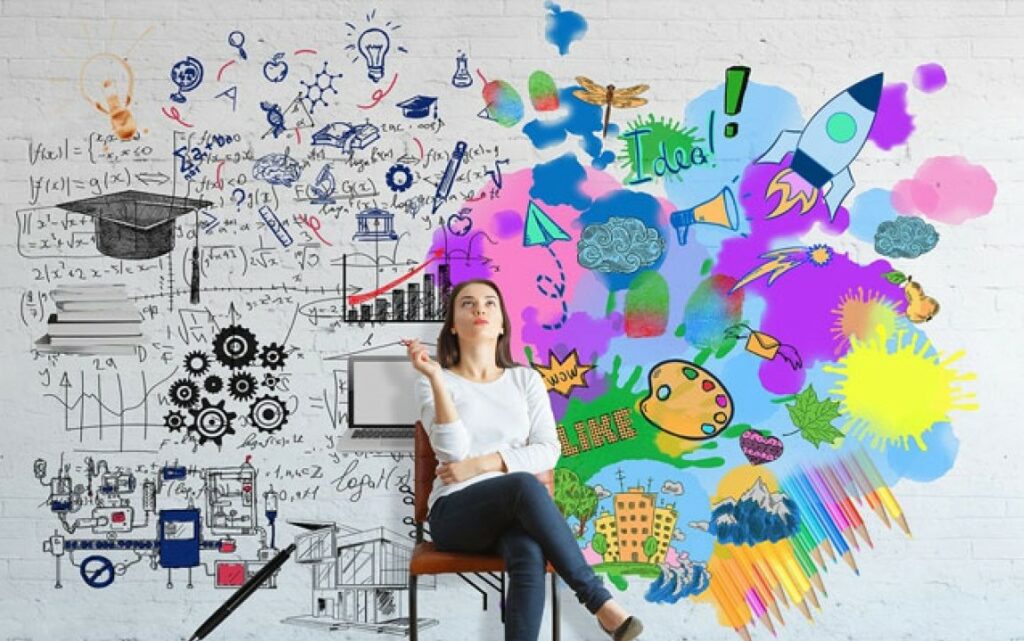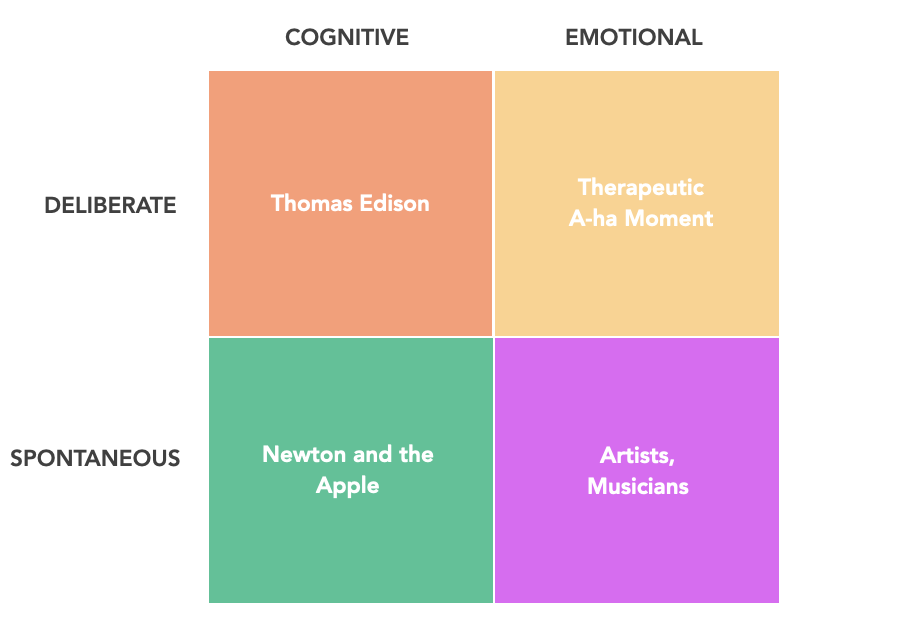
Creative pursuits, like dancing or drawing, are often seen as innate skills, leading many of us to dismiss exploring our talents. We view them as exclusive to professionals in the arts. However, creativity is not just skill-based; it’s a way of thinking. Knowing the various types of creativity and creative thinking will open the doorways for our special genius to manifest in reality — no matter what we do for a living. (Estimated reading time: 10 mintues)
“Create with the heart; build with the mind.”
— Criss Jami
Las Ramblas is one of the busiest boulevards in Spain. It was crowded with tourists and street performers plying their trade on the warm summer day when I took a stroll there,
At first, the chaos, colors, and cacophony of sounds were an assault on my senses, but soon I became acclimated, and I blended with Barcelona’s bustling urban culture.
A solitary artist caught my eye as I walked past the human statues, jugglers, mimes, fortune tellers, and street vendors making paella and tortillas. I stood behind the older man who was carefully painting strokes on the canvas. The artwork was in its early stages, but it looked like he was painting a scenic image of Barcelona’s waterfront.
I marveled at his meticulous care and his apparent mastery. It made me painfully aware of my perceived inadequacies. At the age of 20, I hadn’t discovered my strengths. I felt mediocre in the subjects I was studying in college—a tough place to be in for an ambitious person like me.
“Wow! You’re amazing at what you do!” I said to the painter.
He came out of his semi-trance, turned towards me with his bespectacled eyes, and gave me a warm smile.
“Don’t worry, my dear. You’re amazing too. I can paint well, and you can do something well, too,” he replied.
I nodded, half-convinced, and thanked him. Looking back, I wish I had expressed more appreciation to the Spanish artist for his fatherly assurance. It planted the seed of curiosity in my spirit to discover my inner artist.
Like me, many of us need to do more to find out where our creative gifts lie. We’re quick to dismiss exploring our talents because we see creativity as a skill, like dancing or drawing, that we must naturally be good at. Some think creativity is accessible to anyone and can be learned through seminars and workshops.
So which one is it? A bit of both. We are born with unique, intrinsic creative abilities, but we must learn what they are and the best ways to tap into them. Knowing about the types of creativity and creative thinking will open the doorway for our genius to manifest in reality.
What creativity is and isn’t

The most common misconception about creativity is that it’s exclusive to people in artistic fields – singers, painters, dancers, chefs, graphic designers, and stage performers.
The reason that people assume this is that they confuse creativity with artistry. Yes, an artist is creative, but so is an accountant, engineer, attorney, or psychiatrist—creativity is a way of thinking, not only a specific ability.
Shawn Hunter, author of “Out Think: How Innovative Leaders Drive Exceptional Outcomes,” defines creativity as “the capability or act of conceiving something original or unusual.” It shows in our professions and our ability to solve everyday problems like deciding what to make for dinner or how to convince our kids to clean their rooms.
The byproduct of creativity is novel solutions and breakthrough ideas that we use to develop something original or to overcome challenges. While knowledge, experience, and skill play an essential role in the creative process, our brain’s problem-solving and decision-making sequences are also necessary.
How to incorporate different types of creativity in certain activities is not always obvious. For instance, you might be a janitor or a bank teller, and wonder how you can foster creativity in your work.
Fortunately, there are many ways to boost creativity in nearly every type of job. According to creative director and author Stefan Mumaw, creativity has two major components:
1. Novelty: The ability to solve a problem in a way that’s original, unexpected, and has not been done before.
2. Relevancy: The solution should be relevant to the issue or project.
When we put these components together, we’ll see that creativity is nothing but having the capacity to solve problems in new and original ways. That is something that anyone in any situation can do, and they can get better at it with more focus and practice.
Why it’s important to know your creative strengths
Creativity is a core human ability that is becoming increasingly important in our economy. According to a 2020 World Economic Forum article, creativity is among the top fifteen skills for 2025; and one of the four capabilities students should have (in addition to communication, collaboration, and critical thinking/problem-solving.)
This indicates that creative thinking is increasingly in demand in the workplace, and employers place a high value on those who can come up with original ideas and think outside the box. Having teams with this ability leads to innovative products and services that stand out in the market and gain consumers’ loyalty.
Another reason creativity is in high demand is the rise of artificial intelligence, robots, and automated work processes in many parts of the world. This new technology is replacing many of the repetitive jobs that humans do. However, technology can’t replace creative thinking, which requires a sophisticated and intricate way of processing and connecting ideas.
Companies don’t want analysts who just crunch numbers. They want people who can analyze and develop solutions based on what they identify in the numbers. Media outlets are not looking for reporters who regurgitate facts and figures, but who can narrate news in compelling ways that get the attention of viewers and listeners.
On an individual level, we stand to benefit tremendously by learning about our creative strengths and types of creativity. It increases our sense of wellbeing, boosts self-confidence and self-esteem, and gets us ahead in our professional lives. We know how to optimize our performance at work and in our personal lives and ultimately get more quality work done faster.
Seven different types of creative thinking

Creativity involves various types of thinking. The more approaches we can take to problem-solve, the better our creativity will flow. These seven types of creative thinking play a vital role in the process:
1. Divergent thinking: When you take a single idea and break it down into many concepts, you use divergent thinking. We use it to brainstorm and generate as many ideas as possible. It gives us several ways of looking at an issue or a problem.
2. Convergent thinking: This type of thinking combines facts, data, and information from various fields and sources in one place. Once you gather all the knowledge, you generate a solution. Unlike divergent thinking, there is no room for ambiguity.
3. Lateral thinking: This is a way of solving problems where we imagine solutions using a creative and indirect approach that cannot be found using simple reasoning. It results in ideas that may not be obtainable using traditional step-by-step logic.
4. Emotional thinking: This creative thinking benefits empaths or anyone on the more emotional side. While creative work involves analytical thinking, it’s also part of intuition. If a person has a strong gut feeling about a particular idea, it could turn out to be a successful one.
5. Aesthetic thinking: The ability to appreciate beauty and art is something that we all possess. It can help us discover and create harmonious and pleasant things for the senses. Noticing color, composition, shape, and structure are part of visual-oriented aesthetic thinking. Rhythm, tempo, and melody are forms of aesthetic thinking related to music and drama.
6. “Aha” inspirational thinking: The classic “aha” moment is a product of creative thinking that originates from the subconscious mind – usually after a period of gestating an idea. When we receive these insights, it feels like it appears from nowhere and offers a rapid burst of focus and clarity.
7. Systems thinking: This “connect the dots” type of thinking describes an ability to see how things are interrelated to form a larger whole. People who are strong in systems thinking know that if one thing is changed, the whole system can change. This can be invaluable when a harmonious interdependence of several parts is critical to success, whether it be a project or a personal situation.
Four types of creativity

In a 2004 research paper by neuropsychologist Arne Dietrich, she laid out four creative insights as an alternative way to classify the different types of creativity. She suggested that creativity is either cognitive or emotional and deliberate or spontaneous. She laid out these four possibilities in a four-square matrix:
1. Deliberate cognitive
Deliberate and cognitive creativity is the type of creativity that comes from consistent work in a discipline. You’re taking repeated and intentional steps to formulate ideas, invent products, or resolve issues. Those who use this type of creativity start from a base of knowledge gathered through study, experience, and other forms of learning.
The area of the brain that’s engaged is called the prefrontal cortex, which allows for information gathering and prolonged periods of focus. An example of someone who exhibits this kind of creativity is an inventor like Thomas Edison, who ran experiment after experiment before he could come up with an invention, like the lightbulb and motion picture camera.
How to use this type of creativity:
- Engage in extensive research on your topic.
- Focus your attention on a problem for an extended period.
- Take your time with the process; give yourself plenty of time to connect with the stored information in your brain.
2. Spontaneous cognitive
Have you ever found yourself stuck while working on an idea for a project that you put aside for a couple of days, then suddenly you get a flash of insight about how to do it? These “eureka” moments are a product of spontaneous cognitive creativity.
This type of creativity engages the brain’s basal ganglia, the part of the brain where dopamine is found and works outside conscious awareness.
Someone who utilizes spontaneous cognitive creativity has to step away for a while so that the subconscious mind can work on it. This allegedly inspired Isaac Newton’s thoughts on gravity when he saw an apple falling from a tree.
How to use this type of creativity:
- Educate yourself about what you’re working on and take regular breaks.
- Engage in unrelated activities or go about your routine while your brain works on the idea.
- After setting up the problem, carry a notebook so you’re ready to write down insights that spontaneously arise during your day.
3. Deliberate emotional
If you’ve ever received insights after reflection and sitting quietly, you’ve experienced deliberate, emotional creativity. The brain’s cingulate cortex and amygdala regulate this form of creativity using a combination of logic and emotional sensitivity.
The breakthroughs don’t actually come out of nowhere. They appear after we spend time asking and pondering questions instead through research and studying.
How to use this type of creativity:
- Choose a specific issue or challenge you’d like to mull on and that you can’t find answers to using only logic and rational thinking.
- Explore the matter in any activity that connects you to your emotions, like yoga, meditation, or therapy.
- Be open to receiving whatever insight you get, even if it doesn’t make sense to you initially. If you feel strongly about it, it’s valid.
4. Spontaneous emotional
This type of creativity is considered one of the most elusive because of its mystical nature. Great artists and musicians like Mozart and Leonardo Da Vinci were known to experience epiphanies or “aha” moments that come from sudden flashes of inspiration that they channeled into their work.
Spontaneous creativity can’t be forced and requires patience and setting the right conditions for it to blossom. Since it’s emotional, it originates from the amygdala, where they’re processed.
How to use this type of creativity:
- Create the right environment to elicit spontaneous emotional creativity. Decorate your home or office with things that inspire you and make it aesthetically pleasing.
- No knowledge is required for this type of creativity, but you’ll need the skills to create what you envision. Tap into your creative strengths, whether in art, writing, music, dance or cooking.
- Often ideas come to you in dreams, so keep a dream journal where you can note down any pictures, narratives, or sudden realizations you get.
As an idea-generating organism, creativity is our birthright. It diminishes if we don’t use it, so we must channel the continuous flow of good ideas and apply them in our lives. When we engage our creativity, the possibilities for growth and the advancement of society are endless. You hold the keys.
All my best on your journey,
Seline

Question for you: Which types of creativity are you strongest at? In which areas of your life do you apply it, and how?
Did you like this post? Sign up below, and I’ll send you more awesome posts like this every week

Definitely an artistic type here – lover of painting and writing! I really enjoyed reading this piece. There is a lot fi good information here, a lot that I never really thought about before, so now I have things to ponder. Th thing that always kinda bums me out is artists are often undervalued or totally discounted and ignored. It is a sad thing